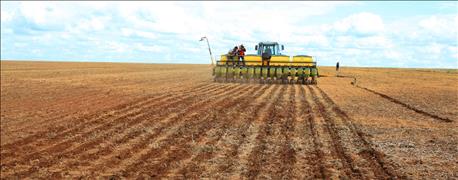
In part one of this series we outlined some of the ways farmers in the U.S. and Brazil compete as the two largest soybean-producing countries on earth. Here we'll take a deeper look at financial options as well as land and production costs.
As we mentioned, more and more Brazilian farmers are planting two crops now – a soy crop followed by second crop corn, or Safrinha, ("little crop" in Portuguese). With two crops, the Brazil advantage plays itself out in land costs — and possibly machinery costs, notes Purdue economist Michael Langemeier. Meanwhile, U.S. farmers are stuck with higher land and labor costs, and yet mostly without the second-crop revenue.

A Brazilian farmer begins planting in Nova Mutum, Mato Grosso. Photo by Lenine Martins/Secom-MT
So who's got the edge now that commodity prices remain weak? The big picture - world stocks, slowing Chinese demand, big global production – has soybean producers on a downward price spiral. While that scenario means across-the-board economic pressure, those laden with higher land and equipment costs are most vulnerable.
Score one for Brazil.
Financial edge
Even so, financing may be the area where U.S. farmers take the lead. Once Brazilian producers began tallying up their new, higher production costs, they may need to make a call to the bank, which won't likely offer much encouraging news. Under the Ministry of Agriculture's austere seasonal crop plan, there's less money available for cropping loans. And farmers are going to have to pay more for what's there. Only about $58.8 billion has been set aside for low-interest ag loans this season, versus some $69.6 billion for 2014-15, based on the mid-July exchange rate in 2014.
Facing a shrinking economy, Brazil is setting some staunch budget cuts — even to the extent of cutting money for agriculture, a sector that is estimated to account for an annual trade surplus of $76 billion.
~~~PAGE_BREAK_HERE~~~
Some midsummer numbers from the Mato Grosso institute for projected 2015-16 costs make that much clearer. If institute specialists are right, it will cost Mato Grosso farmers $364.19 to produce an acre of 2015-16 soybeans, including land, labor and everything else. Out of that, $37.90 is their per-acre land cost — down from $51.70 last season, and $58.63 in 2012-13.
Related: Brazilian consultant sees bigger soy crop coming
Depreciation on buildings and machinery is $17.01 per acre of that total per-acre cost, with maintenance and insurance barely registering on the scale, at 26 cents per acre. Land costs for farms closer to port infrastructure, like Parana state, will no doubt be higher, but in compensation, Mato Grosso producers receive less for their beans at any price due to distances traveled to and from the farm gate.
Meanwhile, 2015-16 fixed costs for U.S. farmers make it harder to weather a price storm like the current one. David Asbridge, at NPK Fertilizer Advisory Service, says it will cost a total of $472.13 to produce an acre of soybeans in 2015. Out of that, $301.88 goes to fixed costs, like machinery, equipment and land. Iowa State University showed total cost of production in 2014 was $557, while University of Illinois projects 2016 soybean costs on highly productive central Illinois ground at $653 per acre, likely due to high cash rents.
Asbridge points out that some U.S. farmers who came to an agreement on cash rents back when prices were higher are likely to face extra difficulties lowering costs in the new-world price order. Cash rents for farmland in Brazil are nearly unheard of. Rents are most often paid according to the value of a bushel of soybeans on a given day each year, so that the landowner shares the price risk with the tenant.
Give this one to the Brazilians.
Read more from James Thompson at South American Crop Watch.
About the Author(s)
You May Also Like






